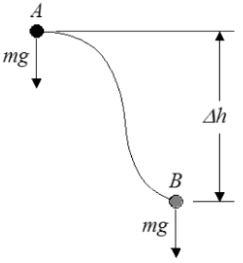Conservative force is nothing but a force. The force is independent of the path of the particle. It means that the conservative force depends only on the object’s position or the start and endpoints. The conservative force will be zero if a particle moves in a closed loop.
The conservative force law conserves energy. The term is derived from the fact that it conserves mechanical energy. Conservative force depends on the principle of energy conservation. Gravitational and electrostatic forces are the most common examples. Other prominent examples are elastic spring, buoyancy, and magnetic force.
Importance of Conservative Force
As mentioned above, conservative force conserves energy. Conservative forces are essential as they enable human beings to store more energy and use it for crucial work later. They help store potential energy and act as a reusable energy source. However, an important point to note is that conservative forces may not exist in isolation in the real world.
Gravitational Force on a Particle
In order to understand the topic better, we will see how gravitational force is known to be a conservative force.
Gravitational Force on a Particle

In order to understand the topic better, we will see how gravitational force is known to be a conservative force.
In the above image, the gravitational force that acts on the particle is known to have a magnitude of ‘mg’. While ‘m’ is the substance’s mass, ‘g’ is the acceleration due to gravity. As shown in the image, the particle moves from the starting point A to the ending point B. Δh denotes the vertical displacement.
The curve in the image shows the arbitrary path that the particle has travelled due to other forces’ influence on the particle or body. However, the arbitrary path is not affected by the force of gravity. The force of gravity depends only on the vertical displacement.
Therefore, the total work done by the gravitational force on the body is:
Wg = mg (Δh).
Where m = body mass.
g = acceleration due to gravity.
Δh = difference between Point B or the final position and Point A or the initial position.
Irrespective of the complexity of the path travelled by the particle, the gravitational force’s work on the particle can be determined. However, knowing vertical displacement is essential. Then, the work done can be determined by using the above formula.
This shows that the gravitational force is independent of the path travelled by the particle. It only depends on the starting point and the ending point. Hence, it proved that gravitational force is indeed a conservative force.
The Law of Conservation of Energy
According to the law of conservation of energy, energy can neither be created nor destroyed. It can only be converted from one energy form to another. It means that isolated energy always has a constant amount of energy. All energy forms that exist comply with the law of conservation of energy.
There is no example of energy that violates the law of conservation of energy. So, in isolated systems like the universe, when there is a loss of energy in one part, there is a gain of energy of an equal amount in other parts. This ensures that the total energy remains the same.
According to the law of conservation of energy, the amount of energy present in any system can be determined using the following equation:
UT = Ui + W + Q.
Where Ui = initial energy present in the system.
W = work done on or by the system.
Q = heat removed or added to the system.
UT = total amount of energy present in the system.
Conservative Forces Examples
Now that we know that conservative force conserves energy and understand the law of conservation of energy, let us explore the conservative force examples.
There are several conservative force examples. Some prominent conservative force examples are listed below.
Stretching of an Elastic Band
Stretching a rubber or elastic band involves the application of pull force on both ends. The mechanical force applied results in temporary deformation of the original structure of the elastic band. When the force is removed, the band returns to its original form. This ensures that the energy of the band is conserved. As conservative force conserves energy, the elastic force is undoubtedly a type of conservative force.
Charged Comb
When we comb our hair, the comb teeth get charged. As we bring the charged comb closer to bits of paper, the paper bits get attracted. This again proves that conservative force conserves energy, and hence, the electrostatic force is an example of a conservative force.
Spring Action
In order to stretch a spring, mechanical force is applied on both ends. The energy present in the stretched spring is contained in the spring and not dissipated. After removing mechanical force, the spring returns to its original form, thereby conserving energy. Therefore, the spring action is also one of the prominent conservative force examples.
Conclusion
Conservative force allows the moving of an object from one position to another and is independent of the path followed. This conservative force conserves energy and allows it to be used for other works. According to the law of conservation of energy, energy cannot be created or destroyed, but only converted from one energy form to another. The conservative force examples are gravitational force, electrostatic force, buoyancy force, and magnetic force.
 Profile
Profile Settings
Settings Refer your friends
Refer your friends Sign out
Sign out




